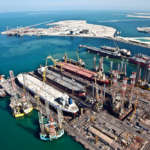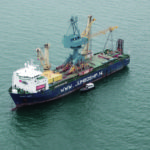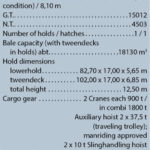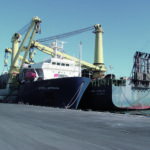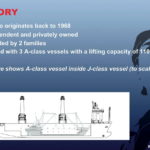Back in the late 1950s, when the container and the pallet were the most remarkable innovations in ocean transportation, Jumbo’s[ds_preview] founding father had a more insightful vision. He developed a concept to handle those pieces which did not fit into a container or on a pallet.
Until that time, heavy-lift cargo was carried using whatever equipment was available – and often as an afterthought. Jumbo’s founder had a view for something better. He saw the opportunity to address a virtually untapped and emerging market and this vision led him to focus on the needs of the heavy-lift transport industry. The first »Stellaprima« was the result. With her four 12-ton derricks she represented a remarkable innovation at that time. From that moment on, Jumbo became established as a pioneer in the heavy-lift shipping industry.
In 1968 Jumbo was founded on this desire to sail against the stream of current trends and find a better course. That same forward-thinking future focus was in place throughout the growth of the company. Every few years a new class of better, stronger, safer and more efficient ships was added to Jumbo’s fleet. Technological developments in each class ranged from evolutionary necessities to revolutionary advancements. Jumbo engineers have invented numerous heavy-lift features which today have become industry standards. Beginning with the original A-class through to Jumbo’s current flagship, the J-class, with a lift capacity of up to 1,800 tons, Jumbo remains true to its founding principles: success comes from looking beyond the needs of today, into the possibilities of tomorrow.
In a recent speech held during a meeting of the Nautischer Verein in Hamburg Peter L. Trepka Bloch, Commercial Director of the Kahn-Group, was wondering: »Didn’t we learn our lessons from the past or did we miss something out?« Mr. Bloch has been following up the development of the project- and heavy-lift markets with his over 25 years of experience in a leading position of the Dutch owner company Jumbo Shipping which belongs to Kahn Scheepvaart bv in Rotterdam. He emphasized: »There has been a considerable growth of this special type of shipping business and not at least owing to the recent downturn of the container market a run on newbuilding orders could be observed. Furthermore liner companies have enforced their interest in this market. We are wondering on what basis these considerable investments have been made when taking into account the unstable situation of the industry’s demand«. Mr. Bloch warns investors and newcomers to abstain from creating possible overcapacities in this risky niche business and reminded of the collapse of the Blaesbjerg-Group about twenty years ago. This first KG-financed heavy-lift company ordered more newbuildings than the market could absorb. Since that time – the beginning of the 1980s – a steady improvement of the freight levels and a more balanced system between the tonnage offered and demanded from the industry provided a relatively controlled development of the market until the economic and financial crisis of 2008 / 2009. Up to 2006 / 2007 the heavy-lift fleet comprised a constant number of 50 to 60 vessels with a lifting capacity of around 500 t. The maximum lifting capacity today (so far) is 1,800 t (2 x 900 t). Jumbo Shipping operates three of them, four additional of this type have meanwhile been ordered by Big Lift and K-Line / SAL. Other companies in this field are BBC, Combi Lift and Beluga Shipping. Since 2007 a sudden and fast worldwide growth of heavylift vessels has occurred. Peter Bloch developed a sceptical view of the future markets with an expected three times increase of project carriers within the coming six years. Taking the present orderbook situation into account the heavy-lift fleet will have grown from around 1 mill. tdw in 2007 to roughly 3.3 mill. tdw in 2013. While Mr. Bloch does not see a big problem for the traditional companies with their skilled personnel and tonnage that has been customized to the current industry demands various other owners are planning to substitute their existing aged break-bulk-tonnage with vessels in size of 12,000 to 20,000 tdw equipped with heavy-lift gear. He doubts if in the long run the huge investments will be able to cope with the break-bulk market which these ships depend upon. The established companies usually follow a conservative policy with regard to financing and operating their tonnage. Despite the increasing demand for energy in the future which will also fuel the demand for additional power stations, refineries, offshore wind craft installations it remains to be seen if there won’t be a significant oversupply of such tonnage.
Today, Jumbo is still a privately owned independent company with a long-range vision for success. It has become an industry leader by focusing on long-term client relationships as opposed to short-term financial gain. They state that autonomy was, is and will remain an essential part of their core strategy. Their clients’ trust and satisfaction are the driving forces behind the continuous development of both their fleet and their employees. It is a formula that has sustained them for almost 40 years and will continue to do so in the future. Clients can rely on them to continue their quest for the safest, most secure, most efficient heavy-lift transport possible. Innovations in technology, logistics and safety will remain their top priority. Its personnel, as well as its vessels, undergo constant evaluation and development to improve where possible. Their staff and crew receive ongoing safety and efficiency trainings. Their newbuilding department is continuously developing new designs for its next series of state-of-the art ships. The Research & Development team is working every day to develop evolutionary changes and revolutionary advancements in the transportation of heavy-lift cargo. By anticipating market needs and the needs of their clients, they continue to stay one step ahead of industry demands. It is a focus on achievement and a desire to exceed expectations that propels them into the future. The reliability, security and innovation Jumbo is known for today will be the same reliability, security and innovation that lead them into tomorrow. The present Jumbo fleet comprises 14 heavy-lift vessels ranging from 5,200 tdw up to 7,580 tdw with lifting capacities from (combined) 500 t up to 1,800 t. A limit of the lifting capacity depends on the ability to handle the cargo ashore rather than the feasibility of constructing stronger heavy lift vessels.
The »Jumbo Jubilee« is a DP2 offshore construction vessel. The Jumbo J-Class vessels are versatile transport, subsea installation and construction vessels. Key features include the twin 900 t cranes, a transit speed of 17 knots, its cargo capacity of 8,000 t, flush decks with dimensions of 120 m by 26,5 m and a cargo hold 80 m long and 12.5 m high. The vessel cranes can be used to install subsea structures with weights of up to 700 t in water depths of over 1,000 m. Modules can be mobilised to the vessel which permit installation of heavier subsea structures in greater water depths.
Projects
Crane dance
A 52 m high navy crane, weighing 564 t, is something not often seen on the world’s seas. In October 2007, Jumbo Shipping made it possible. Korea Logistics Systems asked Jumbo to carry this big crane from the Samsung Shipyard in Koje, South Korea, to the naval base of Portsmouth, USA. To manoeuver the voluminous crane on board »Jumbo Vision«, the undercarriage was turned around while the crane was hanging in the air. A special lifting frame, weighing 70 t itself, was fabricated to handle the vulnerable cargo. The undercarriage was sea-fastened to the rail tracks on deck, the cable house fixed in position, and the crane jib secured with a special frame. After the crane was ceremonially blessed for a safe voyage by Samsung Shipyard’s president the »Jumbo Vision« departed on the 10,352 sea miles voyage routed via the Panama Canal. A few weeks later the heavy-lift ship arrived in Portsmouth were a new challenge awaited the vessel. In currents of over 4 knots the harbour crane was landed on its tracks with pinpoint precision.
Perfect fit
In January 2008, a 77 m long splitter column, destined for Total’s Normandy refinery at Gonfreville near Le Havre, was loaded on »Jumbo Spirit« in homeport Rotterdam. Client Transport Paris International asked Jumbo to transport the enormous tower to the French mainport. Because of the length of the piece, good use was made of »Jumbo Spirit«’s central lift derrick behind the accommodation and the vessel’s starboard side mast crane for loading this long item over portside. The length of the column was just a little more than the length of the ship’s weather deck and the load was spread across the deck, cleverly using the vessel’s own tweendecks. After loading in Rotterdam, the »Jumbo Spirit« arrived in Le Havre only three days later and the column was set down safely on a barge for final transportation to the refinery site.
It takes two to tango
Jumbo named the following loading event with two of their vessels involved. In August 2006, South Korean GS Engineering’s in-house-forwarding company Pantos Logistics asked Jumbo for a transport solution of a 100 m long, 1,522 t xylene column, a 77 m long, 711 t rafinate column, and two 46 m long, 515 t adsorbent towers to be shipped from Ulsan, South Korea, to Sohar, Oman. Loading operations in Ulsan were to take place end November 2007. Although Jumbo initially had difficulties accommodating this typical J-type cargo (because both vessels of this type were already partly booked for the required shipping period) an inventive solution was found since the »Jumbo Javelin« was already scheduled for a Far East / Middle East voyage per November 2007.
The biggest piece and »smallest« piece could be carried on deck by »Jumbo Javelin« herself and she was also to act as crane vessel to load the 711 t rafinate column and the second adsorbent tower on board »Stellaprima« (maximum lift capacity 650 t). Under deck two 900 t EO reactors were skidded over a length of about 40 m to make way for two more super heavies of 1,150 t each, all destined for other ports in the Middle East. A rendezvous between the »Jumbo Javelin« and »Stellaprima« was arranged, demanding tight schedule planning for both vessels, after which the operation described above was successfully accomplished.
The inventive procedures posed multiple challenges for Jumbo’s Engineering and Operations departments as well as the vessels’ crews, but accurate preparations and intensive cooperation paid off. After departure from South Korea, both ships jointly sailed to Sohar, Oman, where one of the world’s largest aromatics plants is being constructed. The aromatics plant will produce key raw materials for polyethylene plastic bottles and polyester fibers. At the port of Sohar, the same feat of strength was performed in reverse, where, after successful completion, both vessels continued separate ways to their next ports of call.






